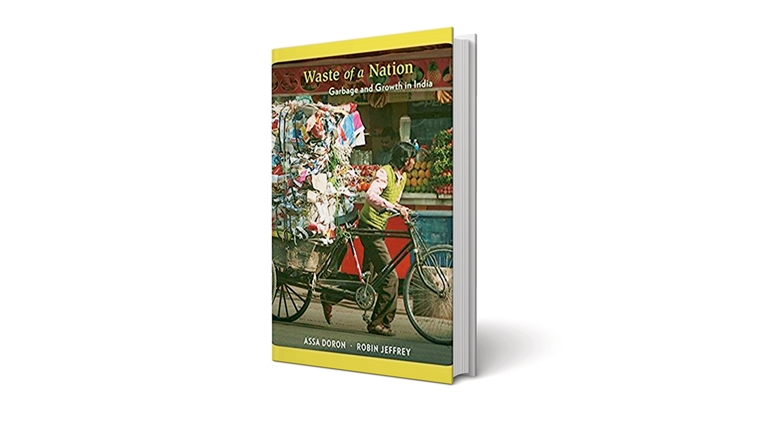Why is India Filthy?
The intractability of waste management in India
Written by Kaushik Dasgupta | Published: August 11, 2018 1:09:58 am

Waste of a Nation, Garbage and Growth in India by Assa Doron and Robin Jeffrey

Waste of a Nation, Garbage and Growth in India by Assa Doron and Robin Jeffrey
India has a law against manual scavenging that goes back to 1993. Yet municipalities continue to employ this undignified form of labour. Hundreds of people lose their lives every year working in the cesspools of toxic gases despite the fact that this law was made more stringent in 2013.
The country’s solid waste law dates to the early years of this century. It was finetuned two years ago. But municipalities across the country continue to struggle with heaps of solid waste. Landfills pockmark the landscapes of our cities, they throw up poisonous gases, invite diseases, and at times collapse, imperilling people’s lives. It has been nearly four years since the Clean India Mission attempted to change this state of affairs. The programme has achieved noteworthy successes, but the task at hand remains a Herculean one.
The country’s solid waste law dates to the early years of this century. It was finetuned two years ago. But municipalities across the country continue to struggle with heaps of solid waste. Landfills pockmark the landscapes of our cities, they throw up poisonous gases, invite diseases, and at times collapse, imperilling people’s lives. It has been nearly four years since the Clean India Mission attempted to change this state of affairs. The programme has achieved noteworthy successes, but the task at hand remains a Herculean one.
This book does not claim to offer easy solutions. Instead, it tries to do what very few have attempted. It takes a multi-disciplinary approach to understand why the country struggles to deal with its junk, refuse and offal. The authors deploy history, sociology, ethnography and policy studies to understand why waste remains an intractable problem for India.
The book places caste at the centre of its concern. That centuries-old notions of purity and pollution — and prejudices — inform how people in the country deal with its garbage should have been fairly obvious to anyone trying to understand the persistence of the problem. But the caste system is also notorious for putting blinkers on even the most well-meaning. Advocacy groups who champion the idea of segregating waste at source and demand the extension of sewerage networks to slums most often do not acknowledge the cultural relationship between caste and garbage. This is what makes India’s challenge of waste management unique.
Caste, as Waste of a Nation shows, complicates efforts to deal with waste. It bestows a ritual characteristic to excrement that goes way beyond the revulsion usually felt by people. “From early childhood, millions of people are presented with the idea that groups designated by birth are the appropriate ones to carry away human waste and other repugnant material. For the orthodox, such ideas are justified by religious doctrines. For the less orthodox, widespread practice is passed on routinely from one generation to another”. Desperate poverty aggravates the problem. People who clean excrement might find their job loathsome, but they also know it’s a permanent source of employment for them. The persistence of manual scavenging derives from centuries of debasement as well as from modern-day insecurities.
The dehumanising aspect of waste management pervades the Clean India Mission as well. The mission is alive to the health hazards of unsanitary conditions. But as the authors argue, aesthetic imperatives overrides other concerns. ‘This vision of a clean India highlights a neat sanitised public space appealing to the middle-classes and the well-off. But it excludes the poor. Public shaming of unfortunate transgressors of the Swachh Bharat Vision suggests that there may be little tolerance of people unable to fit the description of dutiful citizens committed to the regimen of cleanliness and hygiene.’
The public spiritedness demanded by the Clean India mission seems impossible when decent homes and workplaces remain a far cry for a substantial section of people. The rigid goals of Swachh Bharat mean that officials are under constant pressure to declare areas as ‘Open Defecation Free’. The already marginalised become targets of aggressive enforcement. A programme that should have been about human dignity ends up imposing indignities manifested in the photographing of villagers who defecate in the open.
It would have been easy to reduce the intractability of waste management in India to the caste system and poverty. But the virtue of Waste of a Nation lies in showing how other aspects of the problem, ranging from demographics to the rise of a commodity culture — issues noticeable in other parts of the world — intertwine with the more pervasive aspects to give waste a malevolence peculiar to India.
The book does not offer solutions beyond stressing on the informal networks of waste collectors in the country and notions of thrift that have not gone extant despite the sway of consumerism. It also notes that India has another asset when it comes to taming waste: ‘Its proliferation of NGOs, rights-based organisations, self-help groups, resident associations, actions groups and the like.’
The book deserves to be read for the questions it asks. It begins by asking, ‘Why is India so filthy?’ It concludes by talking of two great crises that loom over the country: air pollution and child mortality.






















No hay comentarios:
Publicar un comentario